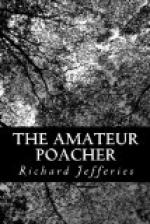We did not see much of Southlands, because the withy-beds were on the lowest ground; but there were six jacks strung on a twisted withy when we got back to the stunted oak and rested there tasting acid sorrel leaves.
CHAPTER IV
EGG-TIME. A ’GIP’-TRAP
There is no sweeter time in the woods than just before the nesting begins in earnest. Is it the rising sap that causes a pleasant odour to emanate from every green thing? Idling along the hedgerows towards the woodlands there may perchance be seen small tufts of white rabbit’s fur in the grass, torn from herself by the doe to form a warm lining to the hole in which her litter will appear: a ‘sign’ this that often guides a robber to her nest.
Yonder on the rising ground, towering even in their fall over the low (lately cut) ash plantation, lie the giant limbs of the mighty oaks, thrown just as they felt the quickening heat. The bark has been stripped from the trunk and branches; the sun has turned the exposed surface to a deep buff colour, which contrasts with the fresh green of the underwood around and renders them visible afar.
When the oak first puts forth its buds the woods take a ruddy tint. Gradually the background of green comes to the front, and the oak-apples swell, streaked with rosy stains, whence their semblance to the edible fruit of the orchard. All unconscious of the white or red cross daubed on the rough bark, the tree prepares its glory of leaf, though doomed the while by that sad mark to the axe.
Cutting away the bushes with his billhook, the woodman next swings the cumbrous grub-axe, whose wide edge clears the earth from the larger roots. Then he puts his pipe in his pocket, and settles to the serious work of the ‘great axe,’ as he calls it. I never could use this ungainly tool aright: a top-heavy, clumsy, awkward thing, it rules you instead of you ruling it. The handle, too, is flat—almost with an edge itself sometimes—and is quite beyond the grasp of any but hands of iron. Now the American axe feels balanced like a sword; this is because of the peculiar curve of the handle. To strike you stand with the left foot slightly forward, and the left hand uppermost: the ‘S’ curve (it is of course not nearly so crooked as the letter) of the American axe adjusts itself to the anatomy of the attitude, so to speak.
The straight English handle does not; it is stiff, and strains the muscles; but the common ‘great axe’ has the advantage that it is also used for splitting logs and gnarled ‘butts.’ An American axe is too beautiful a tool for that rude work. The American was designed to strike at the trunk of the tree several feet from the ground, the English axe is always directed to the great roots at the base.
A dexterous woodman can swing his tool alternately left hand or right hand uppermost. The difference looks trifling; but try it, and you will be astonished at the difficulty. The blows echo and the chips fly, till the base of the tree, that naturally is much larger, is reduced to the size of the trunk or less. Now a pause, while one swarms up to ‘line’ it—i.e. to attach a rope as high as possible to guide the ‘stick’ in its fall.




